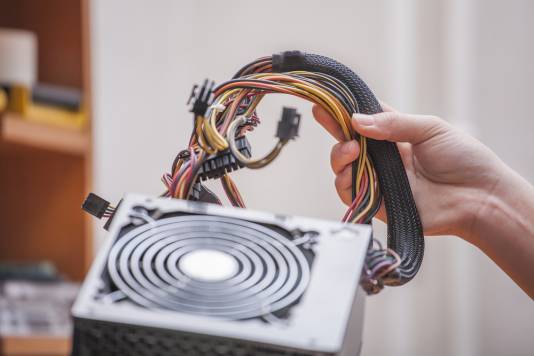If you’re unsure where to start when choosing a power supply for your PC setup, you’re not alone. Buying a PSU (power supply unit) can be difficult due to the huge variety of products on the market – and the abundance of terminology doesn’t make the purchasing process particularly clear either.
If you’re wading through information about nominal wattage, peak wattage and continuous output, or totting up voltage numbers and finding yourself none the wiser, this guide will help clear things up for you.
Choosing the right power supply gives you a solid foundation to work from as you add components, hardware, and software. Every element of your computer will rely on your PSU for a reliable, robust flow of energy in order to function properly.

Opting for the cheapest compatible PSU is not advisable as you run the risk of leaving your computer exposed to power failure or surges which could do serious damage to components inside.
The following information will arm you with the basics and help you to make a better decision on what PSU you need.
Size of PSU
Assessing how much room you have within your system for the PSU is perhaps the first and main consideration to take into account. If your build cannot house the PSU you’ve got your eye on, then you’ll need to choose another.
Don’t purchase a PSU with a size exactly matching the measurements listed on the spec sheet of your case either. You’ll need some room to manoeuvre either side of your PSU to ensure you can install it without scratching or bending the casing. And remember, you’ll also need space for cables.
Shop PSUs at Ebuyer- all at great prices
Wattage of PSU
The output of a PSU is measured in watts, and the power output of desktop computers ranges from 200 watts to 1800 watts. But beware of falling into the common trap of thinking that higher is better when it comes to PSU wattage.
When choosing a PSU, the most important wattage figure to look for is ‘continuous power’ rather than ‘peak power’. The former refers to the output your PSU can sustain during normal use over extended periods, while peak power is the top end of your PSU’s capabilities. Your power supply will only be able to operate at peak power for short intervals, so don’t always go for the higher number.

You need to provide your computer with an appropriate source of power that will help it to run at maximum efficiency. If your PSU only just provides enough power, or if it provides way in excess of what you need, your computer will suffer in the process.
Optimum efficiency is achieved when your computer is using between 40 to 60 per cent of the peak power rating on your PSU. As such, if your system’s TDP (total design power) is 400 watts, a 700- or 800-watt PSU will work efficiently.
Also, keep in mind that you may wish to expand and develop your system over time, so give yourself some room to do so by purchasing a PSU with enough power to meet the needs of your future system as well as your existing one.
Modularity of PSU
You will see the terms ‘modular PSU’ and ‘semi-modular PSU’ when browsing for products, and the difference between their definitions is pretty simple.
Modular PSUs differ from traditional PSUs by offering the option to attach or detach cables as and when they are required, while semi-modular PSUs offer a mixture of fixed and detachable cables.

There can be lots of cables involved when building a PC, and managing them all can become a real headache. That’s where modular PSUs hold a significant advantage over their traditional and semi-modular counterparts: you can simply remove cables that are not in use at any given time, reducing clutter and often increasing airflow around your PSU. You can also quickly and easily replace cables if they break.
The downside of modular PSUs is that they tend to be larger than non-modular units, so if you’re creating a compact system you may find the connectors at the ends of the cables on a modular PSU present an issue.
PSU with 12-volt rails
Your new PSU will feature different rails. (A rail is a simple wire / path inside the PSU which carries electricity of a certain voltage). Each rail provides an amount of current, rated in amps, and the various components of your system draw the current they need from an appropriate rail.
Of these rails, one of the most important is the 12-volt rail which will deliver power to your video card. This is important because your video card is highly likely to be the component which requires more power than anything else in your system. If it’s not supplied with enough power then your system might become unstable or fail altogether.
If you are running one video card, your 12V rail will most likely need to supply it with 30 amps to ensure it runs properly. As with other components, keep in mind that you might upgrade your video card in future, so ensure your 12V rail can cater for those changes and additions.
Shop PSUs at Ebuyer- all at great prices.
Safety of your PSU
A final consideration when purchasing a PSU is the protection offered against power-related issues. Some PSUs feature overvoltage protection, whereby the PSU shuts down if the output voltage increases beyond the safe limit to ensure your computer’s components are not damaged.
Another safety feature carried by some PSUs is overload overcurrent protection, which prevents the power supply from sending excessive current or power load to the computer, shutting your PSU down if overload, overcurrent or short circuits are detected.
These safety features usually add to the cost of a PSU, but given the money you stand to save if they prevent a serious problem, it is often well worth the investment.



